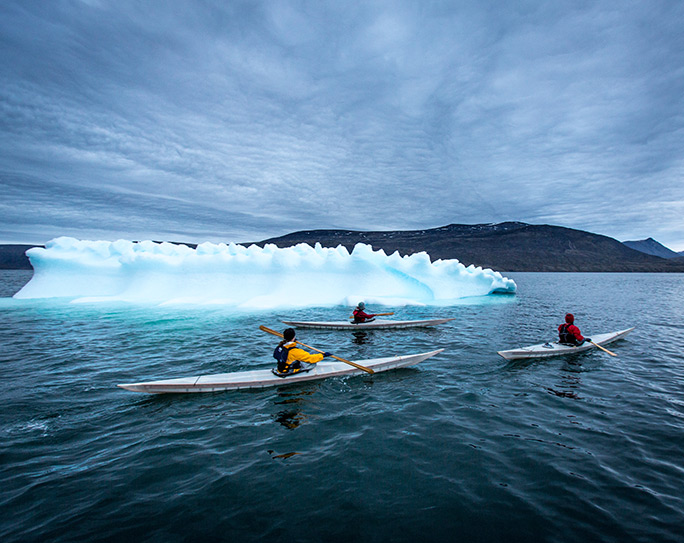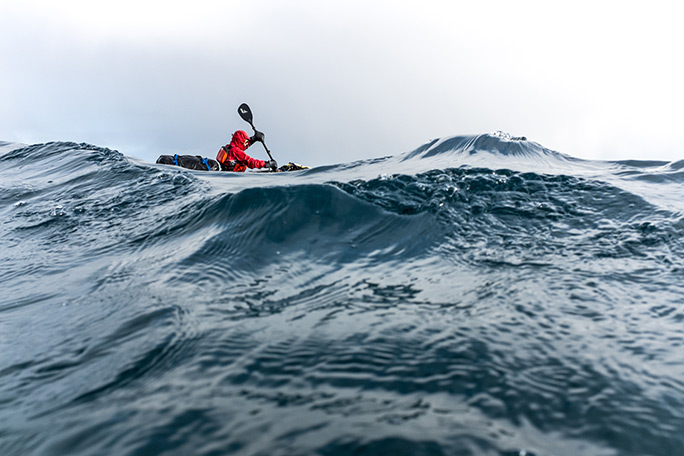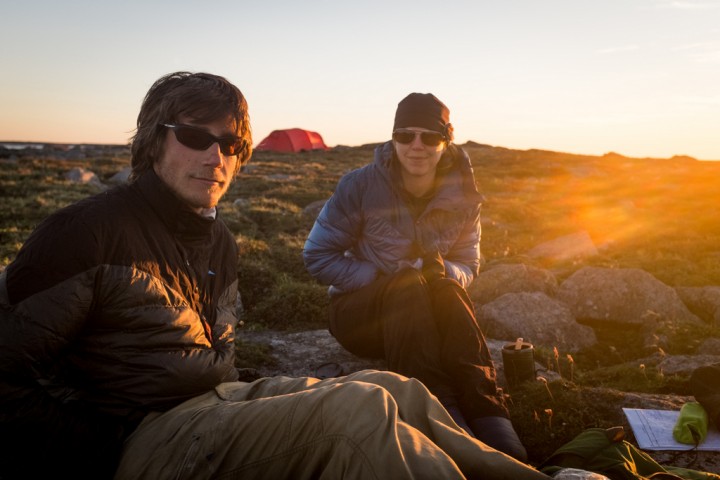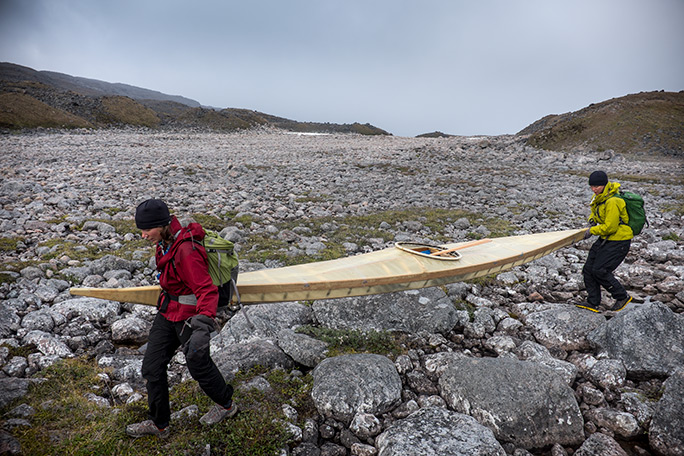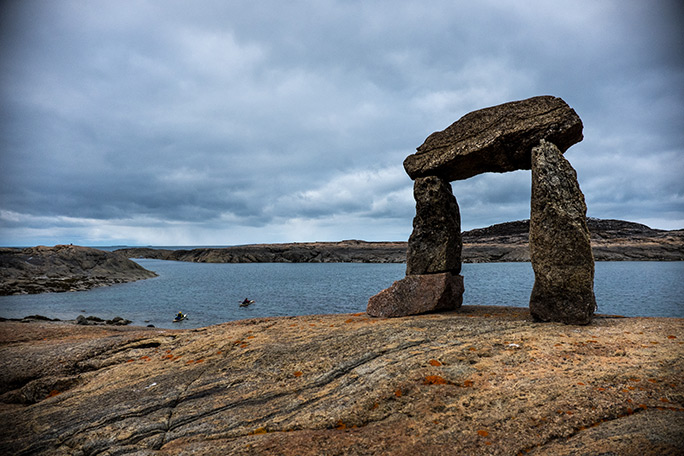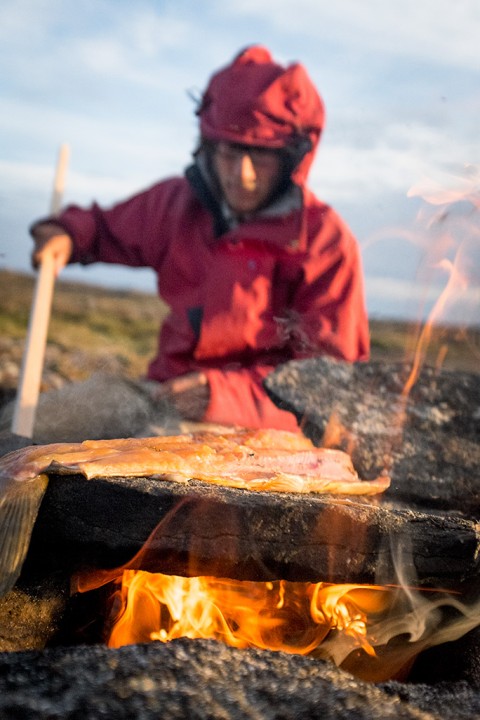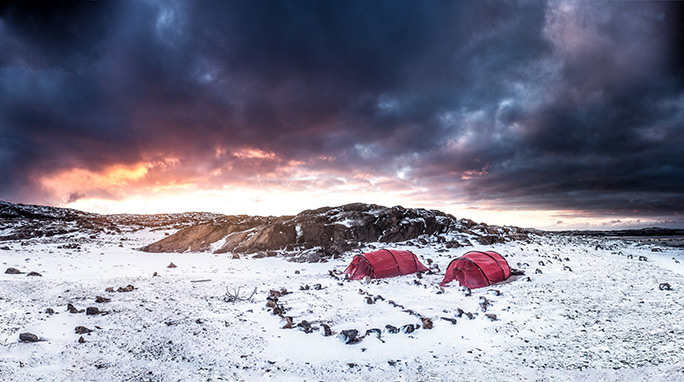After a year of planning, fundraising and hand-building traditional skin-on-frame kayaks, Expedition Q set out on its historic journey across Baffin Island. The team consisted of two couples. Team NRS kayaker Erik Boomer was joined by his girlfriend Sarah McNair-Landry, an accomplished explorer who grew up in a family of arctic guides. Sarah’s brother Eric, also a veteran arctic explorer, and Eric’s girlfriend Katherine Breen, a physician, rounded out the team. What follows are excerpts from a collaborative journal describing their day-to-day life on the expedition. The crew released many of these dispatches straight to their Facebook page via satellite; these posts are marked with the team’s geographic coordinates.
All photos copyright Erik Boomer unless otherwise noted.

1 Jul, 13
After month of building our traditional Inuit style sea kayaks, and two weeks spent crossing the Penny Ice Cap and Auyuittuq Park, we will depart on the next stage or our expedition tomorrow, a two month crossing of southern Baffin Island, using the kayaks we made ourselves.
– Eric McNair-Landry
1 Aug, 13 – 23:23
66.0722N,67.2166W
The past three days have been an excellent test for our kayaks and I’m happy to report that they have performed marvelously well. A gale warning on Cumberland Sound brought high winds and high waves but didn’t slow our progress. The boats proved their stability in the rough water and tracked well through headwinds. At times I felt slightly seasick from surfing the large rollers, but never did my kayak feel unsteady.
– Eric McNair-Landry
5 Aug, 13 – 22:07
66.1500N,68.2166W
For millennia, and until very recently, people lived along this shore, sustained by the abundance of life in the sea. Many people from our home town of Iqaluit, and also from Pangnirtung, have shared stories and advice about travelling along this very route. Some have told us from which section of coastline their families herald, where their grandparents met, and where it is said that one family starved. There are a number of routes that connect the coastline with the large inland lakes. People warned us that one such route, the one that we are currently travelling through Nettilling Fjord, has powerful tidal rapids that make it challenging for even motor boats to navigate. Today we witnessed the awe of these rapids.
– Eric McNair-Landry

8 Aug, 13 – 20:55
66.3333N,69.0847W
After 11 days of paddling across the ocean, we have begun to head inland towards Nettiling Lake. To reach the massive lake we are portaging our boats and shuttling our gear through a series of small lakes. After two days of hiking and paddling, four of the portages are behind us, with two more ahead. To many this may seem like an odd way to travel, but this is a standard technique on this ancient route. The promise of caribou and arctic char attracted people to migrate up the lakes for the summers, and continues to keep people from Pangnirtung migrating inland to hunt and fish. For us, paddling on freshwater and in generally warmer temperatures are a welcome change and a new chapter in our adventure.
– Erik Boomer
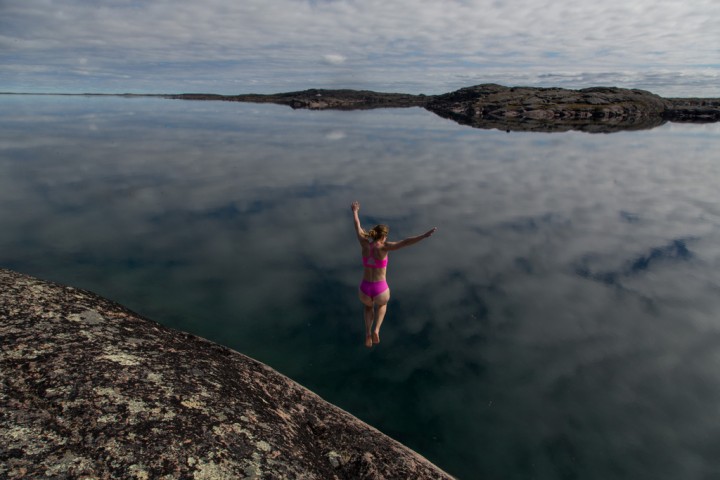
12 Aug, 13 – 20:36
Boomer was the first to strip away his paddling gear and jump off a small cliff into the chilly waters of Nettilling Lake. Kate and I followed his example, diving in to wash off the grit and ocean salt built up from the last 16 days. We dried out in the sun, enjoying the view and glorious weather. Since we arrived at the lake travel has been good, giving us time to cast a line in the water to catch arctic char for dinner, take pictures, sketch, and appreciate how lucky we are to be here.
– Sarah McNair-Landry

15 Aug, 13 – 19:25
65.9500N,71.2250W
Personally, I believe that with this many bugs, relief cannot be found by battling against the swarms and have instead found that a zen-like approach works best. In this war against the blood sucking insects there can be no winners, only itchy losers and dead mosquitoes. Wearing my paddling gear and a bug net I’ve made my peace with the mosquitoes. Try as they might, they can’t bite through my clothing, or my tent walls. Those are my safe spaces and I am prepared to make them mosquito free. The rest of the wilderness belongs to the mosquitoes. So, I’ll just keep suiting up in my bug-proof wear and hoping for a steady breeze.
– Katherine Breen
20 Aug, 13 – 07:59
65.7638N,71.3833W
The seasons are slowly turning; the first blueberries are beginning to ripen, the days are getting shorter and the nights are darker and cooler. We are reminded that our time is limited here; winter is on its way, and we had better be moving on to our food cash.
– Eric McNair-Landry

23 Aug, 13 – 07:19
65.5651N, 71.5404W
The last two days, the winds have been gusting over 20 knots, bringing storm clouds and rain, as we have been painfully portaging, paddling and lining our kayaks up the river. Our bodies are sore from the portage, and our boats have been taking a beating from the sharp rocks along the river banks. The progress may be slow, but we are steadily working our way upstream. With crystal clear blue water and impressive, powerful rapids, and with eddies (and our bellies) filled with arctic char, there is little we can really complain about.
– Erik Boomer

26 Aug, 13 – 17:45
65.2396N,71.6944W
The snow pelted down, stinging our faces and hands and covering the ground in a white blanket. We paddled hard to keep warm. As the snow stung the side of my face, it brought back memories of the snow storm that Boomer and I snow machined through to drop off our food cache. It was nearing the end of April when we set off from my home town of Iqaluit. Geared with two snow machines and our entire cache of food and fuel, we headed out on the 500 km round trip. Now, 4 months later, we are only 41 km away from the two big wood boxes that contain our cache. With only several days of food left, we now have our eyes on the prize. Fingers crossed it’s still there and intact!
– Sarah McNair-Landry
29 Aug, 13 – 15:31
64.8969N,71.3889W
When I told myself that I wouldn’t cry on this expedition I knew that it was only a matter of time before it would be a broken promise. For the record, I lasted three days. It wasn’t the fall into that crevasse, but an accumulation of small things that pushed me over the edge. Feeling a bit too hungry, a bit too tired, and realizing that I was incompetent at the art melting snow on the stove, I shed a few tears on the Penny Ice Cap. It didn’t stop there. Cumberland Sound, Nettilling Fjord, Nettilling Lake and the portages in between have all been made a bit saltier by my tears. I’m the rookie out here, and I’m telling you, unless you are Norwegian, this trip is anything but soft. However, there are days here and there that help me forget about being tough. Days like today, stormed out on the shore of Amadjuak Lake, warm and cozy in the tent and enjoying the momentarily endless supply of treats and goodies that have been awaiting us at our food cache. Our bellies are full and life is good.
– Katherine Breen
3 Sep, 13 – 08:06
64.6939N,71.9375W
I am exhausted. After 10 hours of portaging, we have finally left the shores of Amadjuak Lake and have arrived at Mingo lake, a large lake in its own right but nothing compared to the behemoths we have left behind. Before us lies a labyrinth of smaller lakes and portages that will guide us across the divide and down to Hudson Strait. With aching feet and sore shoulders I feel a sense of accomplishment; and more importantly, that is one portage that I will never have to do again. Doctor Breen has ordered a foot massage, for herself, and so I best be off!
– Eric McNair-Landry
5 Sep, 13 – 20:24
64.6004N,72.4431W
Back on Nettiling Lake, when the mosquitoes got bad, we wished for wind or cold weather to either blow them away or freeze them. Now, two weeks later, the mosquitoes aren’t an issue, but the strong winds and freezing rain have been making the days a bit tough and uncomfortable. Since the cold weather started we all looked forward to portaging so at least we could stay warm. But each of these portages seem to be longer and harder than expected. In short, the ibuprofen is getting taxed.
The lesson is to enjoy every day for what it is. Honestly, we are having the times of our lives out here. Every day there are many moments amidst the hard work and wild weather when we each realize that this experience is exactly what we wanted. We all worked so hard this past winter building these kayaks and have sacrificed our summers to be out here right now. Only two weeks left to enjoy it.
– Erik Boomer
10 Sep, 13 – 08:58
64.5131N,73.2793W
We have skied through the crevasse fields on the Penny Ice Cap, whitewater paddled and hiked passed some of the tallest cliffs in the world, sea kayaked the rocky coast line of Cumberland Sound and portaged through ancient traditional routes marked by inukshuks. We have seen seals pop their heads out of the fresh water in Nettilling Lake, worked our way up the mighty crystal blue Amadjuak River, and and paddled past the vast plains in the interior of Baffin. And now, with our last and longest portage of 9 km behind us, we change gears once again for our final push. Two hundred kilometers of coast line separate us from the community of Cape Dorset, our final destination. Pushing well into September, the huge fast tides, fall storms and polar bears will probably make this our toughest section, and definitely our coldest.
– Sarah McNair-Landry

13 Sep, 13 – 08:40
64.3322N,74.0966W
I thought that my idea to pack a blueberry scoop in our food cache was a stroke of genius. I imagined scoopfuls of blueberries on breakfast granola and filling zip-lock bags with berries to snack on during the day. But it was not to be. So far on this trip I’ve eaten eight blueberries, six of which were ripe. There has certainly been no need for a scoop. It’s been nothing but dead weight. I’m still hopeful that we’ll see an increase in the blueberry crop any day now.
– Katherine Breen
16 Sep, 13 – 21:20
64.4416N,75.0052W
Relentless chilling winds forced us to take cover on two of the four previous days, not an altogether unpleasant happening given the quality of our tents. With 900 km behind us and a mere 100 km left to Cape Dorset, thoughts increasingly turn to the luxuries and projects we left behind 60 days ago. Boomer has visions of pimping out his van with a stove, a juicer and an inverter, and dreams of eating several waffle egg sandwiches. Sarah is hoping for some time to kick back with friends and family over a few cold beers and being reunited with the family dog team. Kate has her eye on a hot shower, a BLT, and getting back to her yoga practice. I am looking forward to the comforting warmth of the cabin’s wood stove and the 3D printer idling on my desk.
– Eric McNair-Landry

19 Sep, 13 – 18:28
64.3756N,75.7612W
After 63 days of traveling across Baffin Island by ski, kayak, and foot we have nearly completed our journey. Spending the summer out here has made for one of the the best trips of my life. But the snow is now here to stay and the puddles are freezing thicker every day. So the big question is, will we make it to Cape Dorset before it is officially fall? We are keeping our fingers crossed for just a few more good travel days on the seas.
– Erik Boomer
26 Sep, 13
A hunter out searching for seals was the first to spot us. He had heard that we were approaching his community, and with the forethought that he might run into us, he brought 4 pairs of new socks as a present for us. Not too long after meeting the hunter, a larger boat circled around and rafted up beside us. A family heading out to their cabin for the weekend spoiled us with hot chocolate, bannock (local bread), chocolates and a big frozen chunk of caribou. As we cooked up the caribou that night in camp, we could see the lights of Cape Dorset off in the distance. We were excited for warm showers and fresh food, yet I knew I would miss life on the expedition. It had been a year of hard work, and our final goal was only 10 km away.
On Saturday morning we rounded the tip of Dorset Island, and the community came into view. To our surprise, a crowd of people was waiting on the beach, cheering, honking horns, and even setting off fireworks. We could not have imagined a better welcome. As we got out of our boats, people hugged and shook our hands. Our boats were carried up on shore, and the community gathered in a big circle around our boats and us to say a prayer for our safe passage. In good northern fashion, a community event and square dance was held for us that night. There was only one thing to do, kick off our boots and join in.
– Sarah McNair-Landry
Editor’s Note: These excerpts tell only part of the story and have been edited for publication. To read the full journal in its original format visit the Pittarak Expeditions Facebook page.
